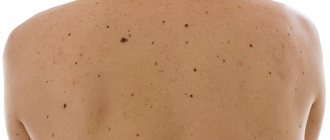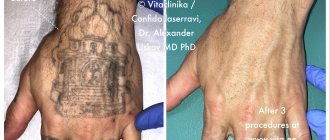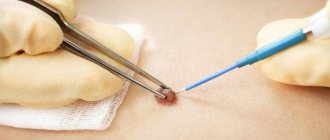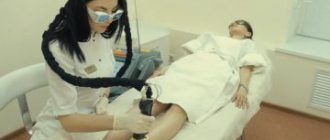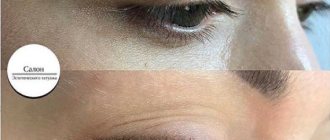Laser mole removal is a procedure that is quickly tolerated by the patient. The main advantage is a good cosmetic result. Depending on the type of mole being removed, different lasers may be used. Whether mole removal will be effective and what the cosmetic result will be after healing depends on the experience of the doctor and the chosen laser.
Of all mole removal methods, laser removal provides the best patient reviews. Especially when removing moles from the face, when the most cosmetic result is important. The procedure is painless (performed under local anesthesia), fast, and causes minimal discomfort. Laser procedures do not limit the patient’s daily activity - frequent dressings are not required, local disinfection is sufficient.
Should moles be removed at all?
A mole needs to be removed only in two cases - if it causes physical or psychological discomfort. When a neoplasm is regularly injured during changing clothes or performing hygiene procedures, it is better to resolve the issue of removal for the sake of your safety. Moles on the face and other exposed parts of the body spoil the appearance and cause complexes and self-doubt. This problem especially worries young girls who always want to remain attractive and not think about how to disguise external defects. You should also remove moles that, without injury, have changed their shape and color, began to hurt and increase in size. It is advisable to remove moles that are located on the palms, soles of the feet, and scalp, where there is a high risk of injury. If you often go on seaside holidays, sunbathe a lot and have large moles on exposed areas of your body, you may want to consider removing them for your own safety. But only after consultation with a tumor removal specialist.
Unattended moles.
Some types of moles can degenerate into one of the most malignant tumors - melanoma (skin cancer). The initial site of formation of most melanomas is congenital pigment spots and warty moles. How does this dangerous development begin?
For example, after damage, a person only notices how the color of the mole begins to change, it enlarges, cracks, turns into an ulcer, and sometimes into a tumor. Therefore, without panicking, pay attention to the above symptoms, especially the progressive enlargement of the mole and change in its color. If all these symptoms occur, immediately rush to the dermatologist. The unfavorable prognosis of melanoma dictates the need for regular monitoring by a doctor. In addition to irritant factors (ultraviolet radiation, trauma), the development of melanoma can also be caused by genetic and endocrine factors. However, in the first place is, of course, excessive exposure to the sun. Ultraviolet radiation in large doses causes irreversible changes in skin cells, greatly increasing the risk of their degeneration. Light-skinned and fair-haired, red-haired people with blue and gray eyes are most susceptible to the mutagenic effects of sunlight. Those at risk also include those who have a lot of freckles, age spots and moles.
Examination of a mole before removal?
Before removing a nevus, it must be examined to exclude the malignant nature of the neoplasm (consultation with an oncologist, histology). Each mole that you want to remove on your own initiative should be at least visually examined. If the mole is on a hidden part of the body, small in size and completely small in size, you can simply observe it for a while. In any case, the decision to remove any skin growths should be made together with your doctor.
Classification of moles:
1. Moles of epidermal origin (borderline, mixed, intradermal).
2. Moles of dermal origin (the most common representative is the blue nevus).
3. Combined moles.
4. High-risk moles (congenital and dysplastic nevi).
The most common type of moles are intradermal nevi - in appearance they are dome-shaped or papillomatous formations, from light brown to black in color, in some cases they can be reddish or whitish.
You can ask any questions you may have, sign up for a tumor removal procedure, or have a free consultation with a specialist by phone:
Sign up
Moles on the back - before surgery. Dermatoscopy:
Doctor: Grishko R.V.
Where can you check moles in St. Petersburg for malignancy?
If you have a problematic mole and would like to have it checked for malignancy and removed, please contact our clinics. Removal of tumors is carried out by experienced specialists who treat each patient carefully and responsibly - dermatocosmetologist, dermatologist, laser removal specialist, dermatologist-oncologist. Moles are tested for malignancy in the laboratory immediately after collecting the material. If you decide to remove a mole at the nearest beauty salon, they will not provide you with this service, which means there will be no opportunity to assess the nature of the neoplasm, which is very important when diagnosing cancer. Laser mole removal can be done in our clinics.
Why are moles dangerous?
Moles such as pigmented nevi can turn into melanoma over time. Sometimes they grow in width for many years and are not bothered by anything else. However, as soon as nodular melanoma forms, the mole becomes convex, begins to bleed, or even metastasizes throughout the body. Nodular melanoma is a very common cause of death. Melanoma itself is not removed by laser. However, many nevi, possible precursors of melanoma, can be removed with laser. Skin cancers (basal cell and squamous cell) can form from moles such as seborrheic keratoses or nevi without pigment cells. Skin cancer is not as dangerous as melanoma. But people often die from it too. It's easier to remove moles with a laser without waiting for them to turn into something more dangerous.
Sign up for a consultation
How is mole histology performed?
Thanks to histological examination, cancer cells can be detected even at the stage of their inception.
Indications for mole histology:
- redness of the skin around the tumor;
- small ulcers on the surface of the nevus;
- burning or pain in the mole area;
- change in color, size, shape of the tumor.
Histology is performed with the procedure of surgical excision of the mole. A small tissue sample is removed and sent for further examination. In the laboratory, biological material is placed in a special suspension and examined under a microscope. Diagnosis is based on the analysis of pigment-forming cells - melanocytes. Laboratory testing may take up to 14 days.
Pathological moles
There are other neoplasms that rightly cause concern in their owner. They can provoke the development of skin cancer. These moles also require removal, but this should be done by an oncologist or surgeon, with the selection of subsequent therapy. Removing pathological moles in aesthetic clinics and centers is extremely dangerous, which is why competent and conscientious plastic surgeons prescribe a series of tests at the slightest suspicion of a malignant growth.
The main signs of a “suspicious” mole:
• Abrupt appearance in adulthood;
• Intensive growth up to 1 cm in diameter;
• Rapid modification of form and structure;
• “Glossy” or rough surface, disappearance of the skin pattern from the elevation;
• Thinning texture;
• The appearance of pronounced asymmetry;
• Peeling of the surface followed by the formation of a crust;
• Presence of itching and burning in the area of the tumor;
• Partial or complete loss of hair from the surface;
• The appearance of depigmented areas, complete or partial change in color;
• Ulcerations on the surface;
• Formation of daughter nodules;
• The presence of hyperemia and swelling around the nevus;
• Formation of new nodules directly on the surface;
• Bleeding (sudden or with minor trauma);
• Separation of moisture and exudate.
Are there any restrictions after mole removal?
A small crust forms at the site of the mole, which, after complete drying, comes off on its own, leaving clean, healthy skin in its place. Under no circumstances should this process be accelerated, because an unsightly scar may form in place of the crust. You should not sunbathe for a month after removing a mole. Before going outside, if it is an open area of the body, use a cream with SPF 50+, which provides a good level of protection against ultraviolet rays.
Restrictions that must be followed for 2-3 weeks after mole removal:
- Avoid contact with water
- Refrain from visiting baths, saunas, swimming pools, and open water bodies.
- The place where the nevus used to be must be protected from any thermal effects.
- Both natural and artificial tanning in a solarium are prohibited.
The essence of the occurrence of moles
You have probably noticed the appearance of new moles where there were none before. In fact, moles form throughout a person’s life. Their secret is quite simple: these small and large dots on the body represent an excessive local accumulation of melanocytes under the skin - cells responsible for the production of melanin pigment. Each mole is fundamentally different from the other in size and shape.
Each mole has its own life cycle. As a rule, the first nodules appear in infancy, and by 7-10 years they acquire their final form, although they may change over time. First, a nevus appears - a flat tiny spot of a dark shade; then you can notice how it grows, becomes voluminous and convex. The intensity of the color and shape of the surface directly depends on the concentration and location of melanocytes - the fewer there are and the deeper the layer of their localization, the lighter the mole. If multiple cells are located in the upper layers of the skin, the mole has a distinct contour, a “puffy” shape and a dark color.
Is it safe to remove moles?
Today you can often see offers to remove moles using the laser method in a cosmetology office. For safety reasons, this is absolutely not worth doing. To carry out high-quality nevus removal, you should contact specialized medical institutions, where the procedure is performed by experienced medical workers. It is possible to immediately send the material for histological examination. Beauty salons do not provide this service. If a mole is suspected of being oncological, it is not recommended to use the laser method, which does not allow taking a tissue sample.
If the technology is followed, the nevus removal procedure is absolutely safe. The laser acts locally only on tumors, without heating neighboring organs and tissues.
Is it possible to remove all moles with laser?
During the consultation, when a patient requests removal of a mole, the doctor carefully examines the mole and selects the most suitable removal method. If the mole has no lesions and dermatoscopy or siascopy does not reveal signs of atypia, removal for medical purposes is not required.
In this case, the removal of a mole is carried out only when the patient wishes it for aesthetic or comfort reasons, and in each case the method of removing a specific mole is selected individually. However, even unchanged moles are recommended to be removed if they are often injured by clothing, jewelry, shaving, and so on.
Moles are usually removed with a laser after administration of local analgesics. Laser mole removal is a quick procedure and the wound heals faster than surgical removal as there are no stitches, so a better cosmetic result is achieved. In addition, the likelihood of postoperative complications is much lower.
Care after mole removal
Within 10-14 days after laser removal of a mole, you should pay attention to your health and follow all doctor’s recommendations.
What not to do:
- Always cover the scab with a bandage or plaster - this can slow down the regeneration process.
- Expose the skin to heat - do not go to the bathhouse or sauna, sunbathe in the sun, or make warm compresses.
- Be in direct sunlight - even after the crust falls off, you must apply sunscreen before going outside (if it is a visible part of the body).
- Play sports - regardless of the location of the mole, it is necessary to exclude physical activity for 1-2 weeks.
- Take a hot bath - on the first day after the procedure, you should not wet the mole with water at all. Next, hygiene procedures must be performed with water at room temperature. The ideal option is a shower. When taking a bath, there is a risk that after steaming the protective crust will fall off and an unaesthetic scar will appear in its place. You should also not rub the mole with a washcloth.
If a mole has been removed from the surface of the palms or soles, any physical activity should be reduced as much as possible. To treat the damaged area, use only medications recommended by your doctor. If you notice swelling, redness or pain in the area where there used to be a mole, do not self-medicate, but immediately consult a doctor.
Laser removal equipment
There are several classes of laser devices for removing moles. The most commonly used is a diode laser. Beams of light with the required wavelength are formed inside the device, and from there they travel through a light guide to the mole. The wavelength of the laser light is selected so that it is primarily absorbed by water or blood, that is, it heats them up very quickly. Rapid heating by the laser causes instant evaporation of water from the mole and does not heat up the skin around it or the fatty tissue underneath it. The less healthy tissue heats up, the faster the wound heals and the fewer scars.
Moles and papillomas
Moles are commonly called pigmented formations on the skin. Doctors gave them another name - nevi. They are formed from pigment cells. In fact, a mole is a benign tumor. Most often it is located between the epidermis and dermis. Sometimes one or more moles can be found on the mucous membranes. For example, in the mouth or vagina. Nevi can be of different colors: brown, purple, black, blue, red and others. Sometimes moles are colorless. The reasons for their formation are as follows: Some papillomas, in appearance, are similar to colorless moles. Sometimes they grow and resemble cauliflower. These tumors most often form on the face, neck and chest. The cause of such growths is the human papillomavirus. Infection occurs as follows:
- Sexually.
- Autoinfection. For example: during hair removal or shaving.
- Infection of the baby during childbirth.
- By everyday means. The virus enters the body through microscopic abrasions or cuts in the skin.
In most cases, the reason for removing moles and papillomas is aesthetics, not health. The patient simply does not like the appearance of the growth or it is too noticeable to others. In some cases, neoplasms are traumatized by clothing or a chain around the neck. This forces the patient to see a doctor to get rid of the growth.
Laser Application
A dermatologist can offer the patient several ways to remove tumors. Naturally, the patient will give preference to the one that is the least traumatic and painless. Laser removal of papillomas and warts allows you to quickly get rid of the problem.
The microfractional beam evaporates the growth without affecting healthy tissue. To completely remove the tumor, one procedure is sufficient. There are no scars after using the laser. In addition, blood loss is also excluded.
- Diabetes.
- Blood diseases.
- Oncology.
- Pregnancy.
- Autoimmune diseases.
- Tendency to keloid scars.
- Epilepsy.
After the procedure, the wound heals within two weeks. Many patients who have chosen this method of treatment leave positive reviews on the Internet. The consequences of laser removal of papillomas and moles are clean and healthy skin. Just a few days after the procedure, the patient completely forgets about the eliminated growths. There are no side effects after using the laser.
FAQ:
Is pain relief used?
Pain relief is not used for all types of interventions. For example, cryodestruction, radio wave and laser removal of moles occur in the most gentle way, and doctors do not recommend resorting to anesthesia. Electrocoagulation is also a relatively painless method that does not always require anesthesia.
Anesthesia will definitely be required during classical surgery, when not only the mole is excised, but also part of the tissue. In this case, patients will be given local anesthesia.
How dangerous are moles and their removal from an oncological point of view?
In most cases, moles do not degenerate into a cancerous tumor if they initially do not show signs of malignancy. However, the prerequisites for this may be frequent trauma to the mole and exposure to sunlight.
Dermatoscopy can detect signs of cancerous degeneration:
- uneven edge;
- uneven color;
- bleeding;
- peeling of the neoplasm, cracking;
- fast growth;
- the appearance of compactions and nodular inclusions.
The doctor will give a referral for histology and, when the diagnosis is confirmed, will definitely recommend removing the moles so that they do not lead to cancerous lesions of the skin.
Why is it worth removing a suspicious mole rather than observing it? Statistics show that skin cancer in every third patient develops from a malignant mole, and in 70% the disease is disguised as melanoma.
75% of skin cancer cases are fatal, and at stage 4 the mortality rate is 90%. Do not delay visiting a doctor if a suspicious tumor appears. Removing an aggressive mole is the only chance to get rid of the problem at an early stage.
What are the restrictions for deletion?
Doctors do not recommend removing moles for children. The procedure is possible according to indications in patients over 12 years of age if the mole is in the way and is often injured.
In case of aesthetic dissatisfaction, it is better to remove moles from people over 18 years of age. There are no restrictions on the number of moles removed at one time.
To make an appointment for mole removal in Moscow, call the phone number on the website and contact the administrator: he will agree on dates convenient for you and make an appointment with the doctor, where a specialist will examine the mole and advise on the cost of the procedure according to the price list.
Preparations with a cauterizing effect
Pharmacological companies create various effective and affordable drugs for removing tumors at home. Cauterizing remedies for papillomas help get rid of growths forever. The following drugs can be purchased at the pharmacy:
- “Verrucacid.” It is an oily liquid whose main ingredient is phenol. The substance is quite aggressive. The liquid should be applied with an applicator exclusively to the neoplasm. Care must be taken to ensure that the product does not come into contact with healthy tissue. “Verrukatsid” is applied twice with an interval of five minutes. Usually one procedure is enough. The drug is contraindicated for the treatment of pregnant women and children under the age of seven.
- "Ferezol". This drug has a bactericidal and cauterizing effect. The liquid is applied pointwise, several times over the course of an hour. The procedure is repeated after eight days.
- "Solcoderm". This medicine contains oxalic, nitric, acetic and lactic acid. It is recommended to use the drug under the supervision of a specialist with higher or secondary medical education. “Solcoderm” is applied several times pointwise until the neoplasm takes on a yellowish or gray-white color.
Pharmacy preparations for freezing tumors
A doctor must remove moles. You cannot do this on your own. Otherwise, you can provoke a malignant degeneration of the nevus. You can remove papillomas yourself. Provided that the doctor has previously examined the patient and confirmed the diagnosis. And also approved the method of treatment. To do this, you can purchase a remedy for papillomas at the pharmacy, which freezes tumors. The most effective drugs include:
- "Wartner Cryo". Removes not only papillomas, but also warts. The active ingredient of the drug has a temperature of minus 40 degrees, this is quite enough to destroy the cells of the growth;
- "Veruklin". The mixture of gases of this drug has a temperature of minus 50 degrees. The papilloma completely dies off just two weeks after using this remedy;
- "Cryopharma". Contains propane and dimethyl ether. At the exit from the cylinder, their temperature reaches minus 57 degrees. One package is enough to treat 12 tumors. Within two weeks after the procedure, healthy skin is completely restored.

